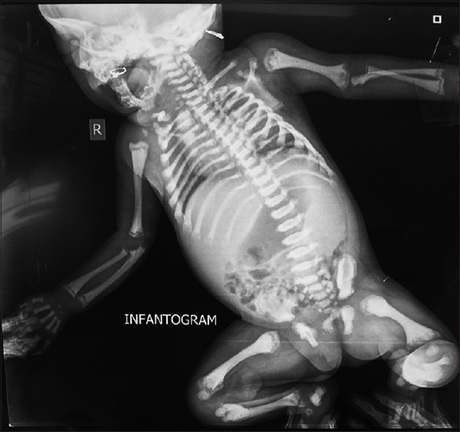Malignant Infantile Osteopetrosis
Main Article Content
Abstract
Background: Malignant infantile osteopetrosis (MIOP) is an autosomal recessive disorder which is characterized by densely sclerotic bone due to defective function of osteoclasts. Overgrowth of bone results in nerve compression and reduction of marrow spaces. It may be complicated by rickets. The main genetic causes are the mutations in the TCIRG1 and CLCN7 genes. Stem cell transplantation offers the only hope for cure. Early diagnosis is of prime importance.
Case Presentation: We report a four month old female infant, who was diagnosed to have MIOP while being evaluated for raised total count, thrombocytopenia, hepatosplenomegaly and optic atrophy. An infantogram helped us clinch the diagnosis as she had most of the radiological signs that have been described. She was also found to have co-existent rickets. Mutation analysis and hematopoietic stem cell transplantation were deferred by her parents due to financial constraints.
Conclusion: MIOP should be kept in mind when the patient presents with hematological abnormalities such as anemia, thrombocytopenia and leukemoid reaction along with hepatosplenomegaly and optic atrophy. Our case is worthy of mention, because a high index of suspicion and meticulous interpretation of the infantogram helped us arrive at the diagnosis.
Downloads
Article Details
Section

This work is licensed under a Creative Commons Attribution-NonCommercial 4.0 International License.
This is an open access journal, and articles are distributed under the terms of the Creative Commons Attribution-NonCommercial-ShareAlike 4.0 License, which allows others to remix, tweak, and build upon the work non-commercially, as long as appropriate credit is given and the new creations are licensed under the identical terms.
How to Cite
References
1. Usta M, Gulec SG, Karaman S, Erdem E, Emral H, Urganci N. A case report of malignant infantile osteopetrosis. Iran J Pediatr
2012;22:421‑4.
2. Gerritsen EJ, Vossen JM, van Loo IH, Hermans J, Helfrich MH, Griscelli C, et al. Autosomal recessive osteopetrosis: Variability of findings at diagnosis and during the natural course. Pediatrics 1994;93:247‑53.
3. Kapelushnik J, Shalev C, Yaniv I, Aker M, Carmi R, Cohen Z, et al. Osteopetrosis: A single centre experience of stem cell tranisplantation and prenatal diagnosis. Bone Marrow Transplant 2001;27:129‑32.
4. Essabar L, Meskini T, Ettair S, Erreimi N, Mouane N. Malignant infantile osteopetrosis: Case report with review of literature. Pan
Afr Med J 2014;17:63.
5. Del Fattore A, Cappariello A, Teti A. Genetics, pathogenesis and complications of osteopetrosis. Bone 2008;42:19‑29.
6. Albers‑Schönberg HE. . X‑ray images of a rare disease. Munch Med Wochenschr 1904;5:365‑8.
7. Subramaniam A, Singh A, Chavan M, Kunte S. Autosomal recessive osteopetrosis: Case report of two siblings. Oral Radiol
2008; 24:80‑4.
8. Phadke SR, Fischer B, Gupta N, Ranganath P, Kabra M, Kornak U. Novel mutations in Indian patients with autosomal recessive
infantile malignant osteopetrosis. Indian J Med Res 2010;131:508‑14.
9. Ashraf M, Mubarik M, Irshad M, Malla RA, Rasool S. Malignant infantile osteopetrosis presenting as failure to thrive. Indian J Child
Health 2014;1:22‑4.
10. Stark Z, Savarirayan R. Osteopetrosis. Orphanet J Rare Dis 2009;4:5.
11. Datta V, Prajapati NC, Kamble M, Pathak S. Osteopetrorickets. Indian Pediatr 2000;37:98‑9.
12. Kaplan FS, August CS, Fallon MD, Gannon F, Haddad JG. Osteopetrorickets: The paradox of plenty. Pathophysiology and
treatment. Clin Orthop 1993;294:64‑78.


